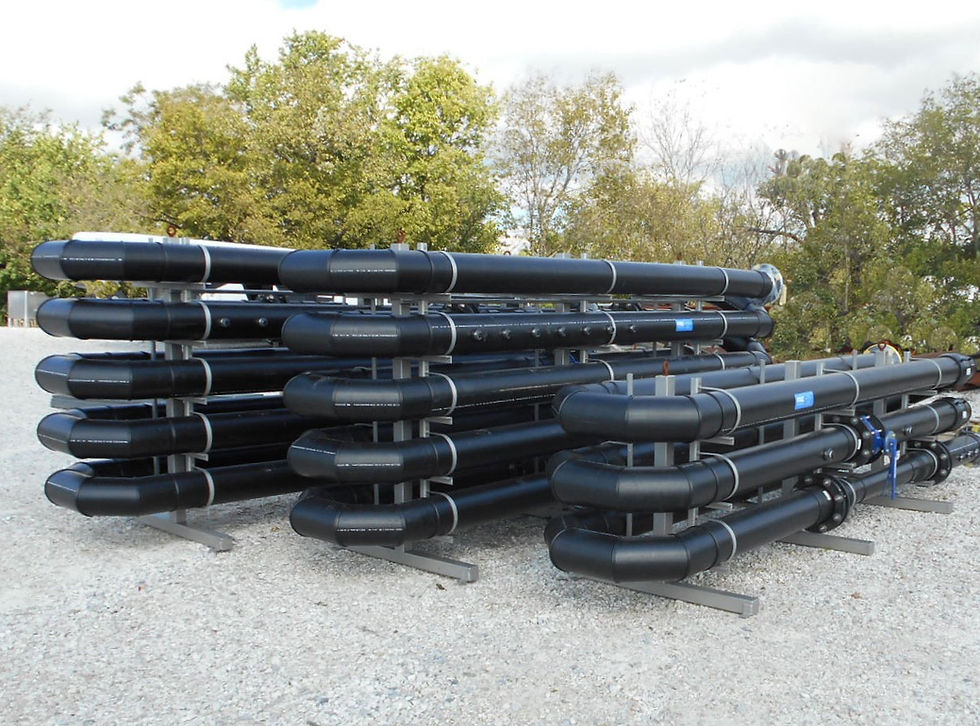
Flockulatoren, sowohl Plug-Flow-Reaktoren (PFR) als auch kontinuierlich gerührte Tankreaktoren (CSTR), bieten die Mischwirkung und Verweilzeit, die zur chemischen Behandlung von Abwasser erforderlich sind. Die chemische Behandlung umfasst Koagulation, pH-Anpassung und Flockung. Koagulantien werden verwendet, um die Emulsionen im Abwasser aufzubrechen und Mikroflocken zu bilden. Die Flockung durch Polymere wird verwendet, um die koagulierten Partikel zu agglomerieren und Makroflocken zu erzeugen, die leicht durch Flotation mit gelöster Luft (DAF) entfernt werden können.
Wie bei allen FRC-Systemen entwerfen unsere Ingenieure jedes Element unserer Flockulatoren sorgfältig, was sie zu den wohl leistungsstärksten chemischen Reaktionsbehältern auf dem Markt macht.








Kompakte Stellfläche und keine beweglichen Teile
FRC PFR-Flockulatoren sind mit statischen Inline-Mischern ausgestattet. Dieses einzigartige Design reduziert die Inline-Rohrgröße für kurze Zeit, um die erforderliche Mischwirkung zu erzielen. Ein weiterer Vorteil ist, dass FRC PFRs eine kompakte Stellfläche haben und so wertvollen Platz in der Anlage sparen.
Bildung von „Flocken“
Ein Koagulans wird zugegeben, um kolloidale Partikel zu destabilisieren. Dadurch bilden sich Mikroflocken oder Pinflocken. Ein Flockungsmittel wird zugegeben, um die Mikroflocken zu agglomerieren und robuste Makroflocken zu bilden. Die beiden Schlüsselfaktoren in diesem Prozess sind die richtige Mischung und die Aufrechterhaltung der Integrität der Flocken.
Um eine ordnungsgemäße Durchmischung zu erreichen, verwenden FRC-Flockulatoren kurze, statische Inline-Mischzonen. Wir reduzieren und erweitern den Rohrdurchmesser über einen kurzen Rohrverlauf in der Reaktorleitung: eine Zone direkt nach der Koagulans- und Laugen-/Säurezugabe und die andere nach der Flockungsmittelzugabe. Dies beschleunigt die Durchflussgeschwindigkeit und verteilt die Chemikalien in und unmittelbar nach der Mischzone.
Das von FRC entwickelte Design verwendet Biegungen mit großem Radius anstelle von 90-Grad-Kniestücken. Anders als die engen 90-Grad-Kniestücke scheren diese Biegungen mit großem Radius die ausgeflockten Feststoffe nicht, nachdem sie sich gebildet haben. Dadurch können die gebildeten Flocken während ihrer restlichen Verweilzeit im Flockulator zu größeren, flauschigeren Partikeln verschmelzen. Da die ausgeflockten Feststoffe nach ihrer Bildung nicht geschert werden, werden weniger Chemikalien benötigt, um den gewünschten Grad an Trennung und Klärung zu erreichen.
Lufteinblasöffnungen
Die Lufteinblasöffnungen führen Mikroblasen in den Flockulator ein. Dadurch wird von Anfang an Luft in die Flocken eingebracht, was eine einfache Trennung beim Eintritt in den DAF ermöglicht.
Visuelle Inspektion des Abwassers während des gesamten Prozesses
Probenentnahmestellen sind strategisch im gesamten Flockulator platziert, um die sich bei jedem Schritt der chemischen Dosierung ändernde Wasserstruktur zu untersuchen. Diese Öffnungen zeigen das Abwasser an diesen Stellen:
Rohabwasser
Koagulation und pH-Einstellung
Flockung
DAF-Wildwassereinspritzung
Baumaterialien
PFRs können wie folgt aufgebaut sein:
HDPE
PVC / CPVC
SS304 / SS316
CSTRs können wie folgt aufgebaut sein:
GFK (Einkammertank)
SS304 / SS316ti / Duplex SS (Doppelkammertank)
Komplette Flockulatorsysteme
Flockulator-Anwendungen können durch Zusatzgeräte verbessert werden, wie zum Beispiel:
Chemikalien-Dosierpumpen
Durchflussinstrumentierung
Bedienfelder einschließlich SPS und HMI mit NEMA 4X-Zertifizierung (SS304-Gehäuse)
Funktionen des CSTR-Flockulators
Kontinuierlich gerührte Tankreaktoren sind Tanks mit Mischern und können anstelle eines Strömungsreaktors verwendet werden. Sie ermöglichen Ihnen:
Reduzieren Sie die Auswirkungen kontinuierlicher großer Schwankungen der Durchflussrate
Längere Verweilzeit für den Koagulations-/Flockungsprozess aufgrund langsamer Reaktionskinetik
Es ist nicht genügend statischer Druck vorhanden, um das DAF-System zu versorgen
